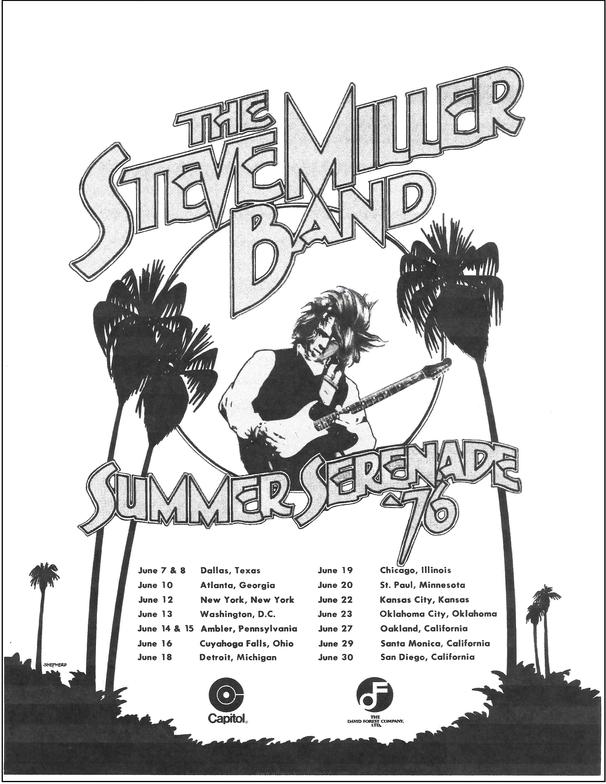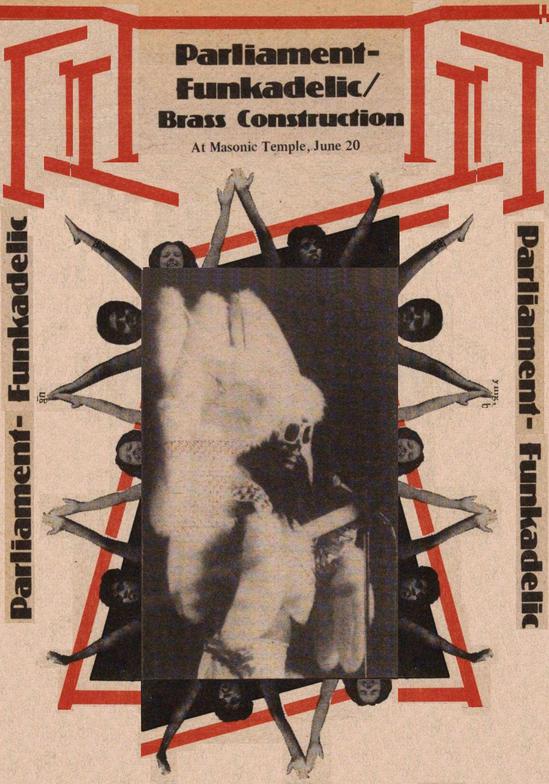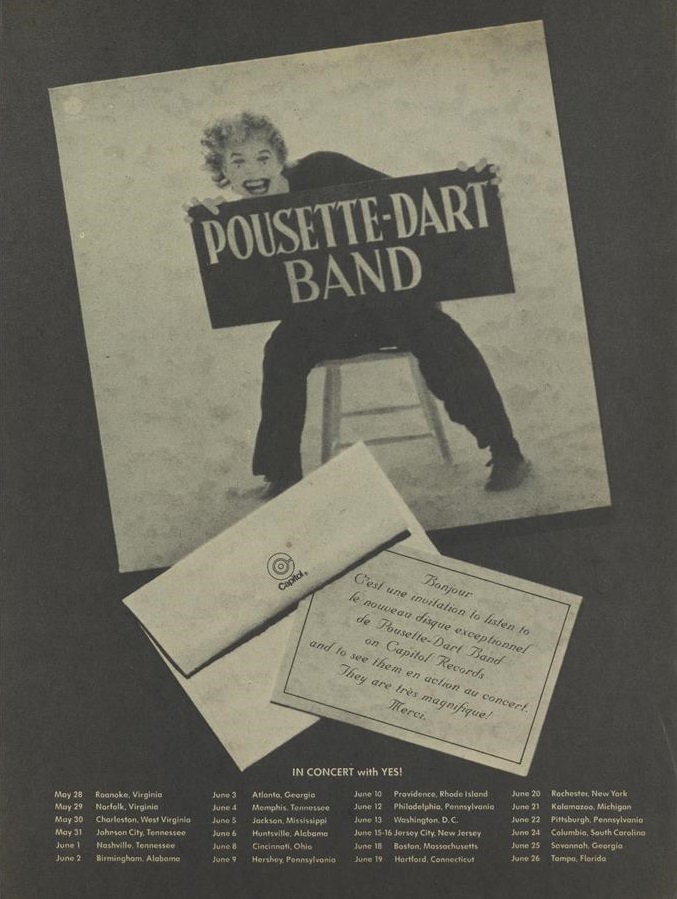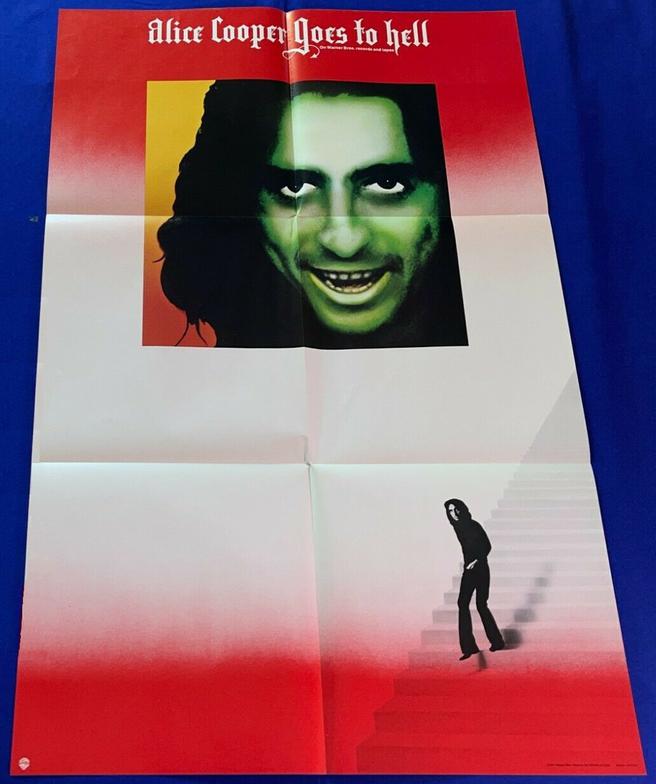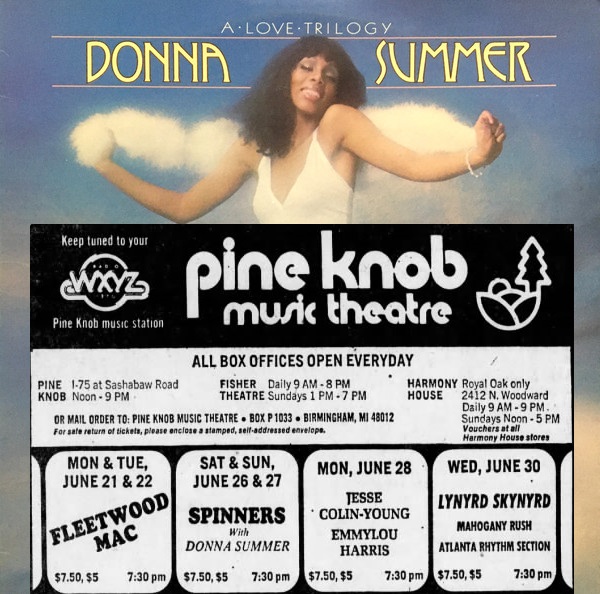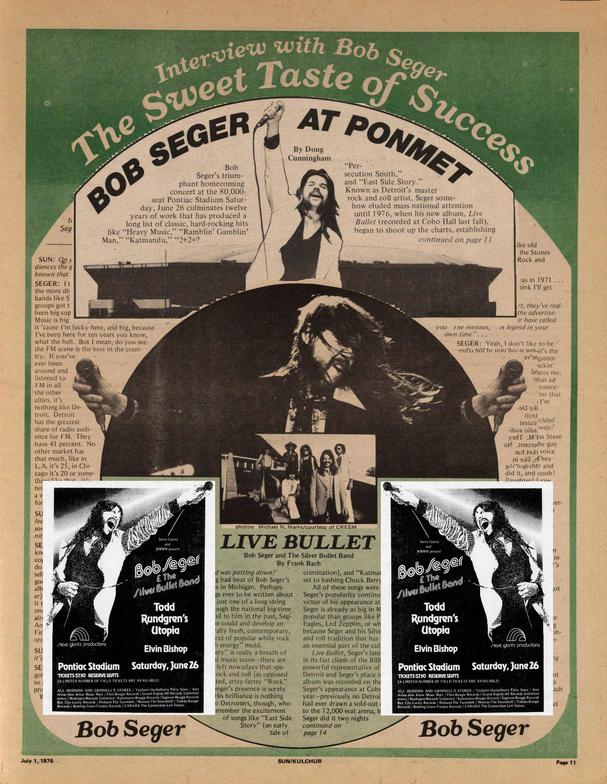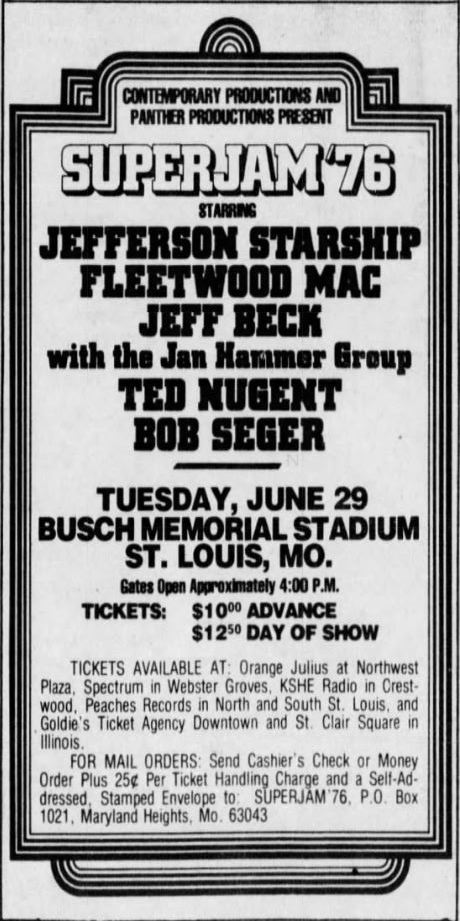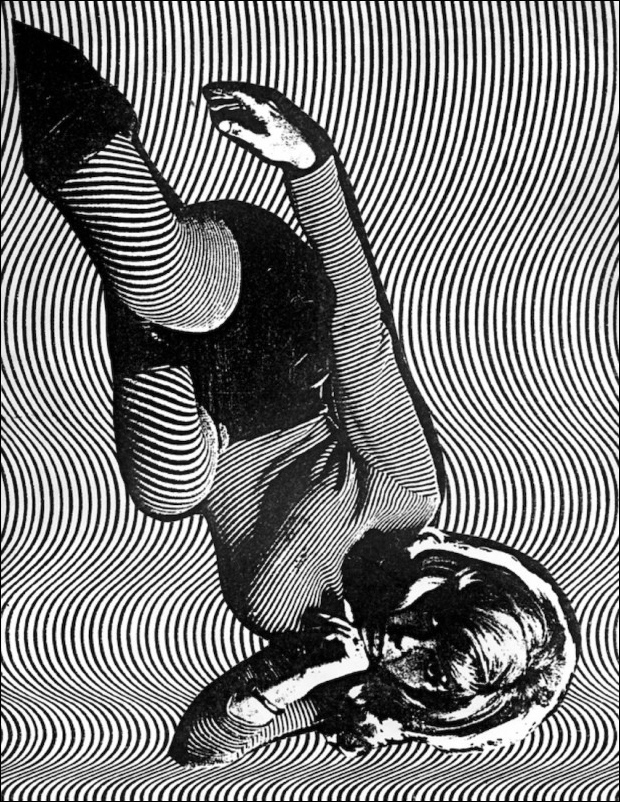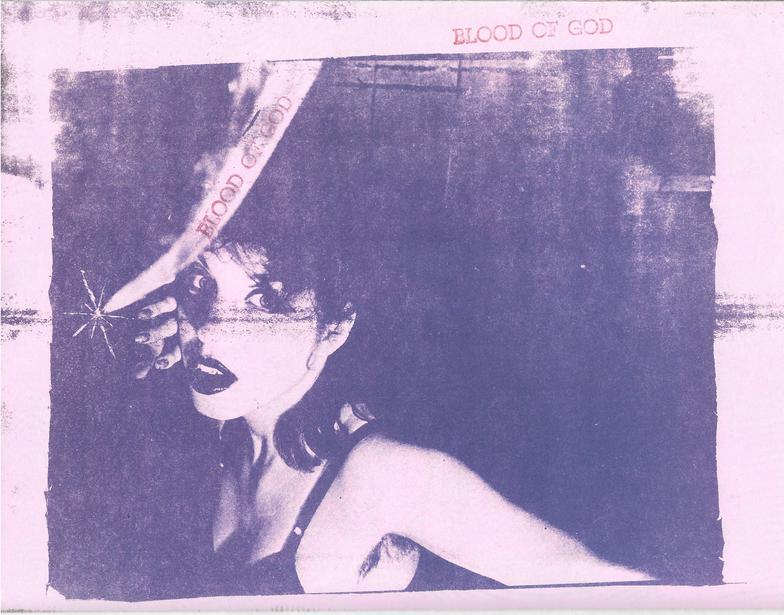Splatt Gallery
Double click here to add text.
Splatt Gallery's History of Michigan Music Posters
Volume Twelve - 1976 - Page Seven
***********************************************************
Poster/ad by Roger Shepherd for Steve Miller at Masonic Auditorium in Detroit, Michigan on June 18, 1976.
Tour poster by Roger Shepherd for Steve Miller with a show in Detroit, Michigan on June 18, 1976.
A University Cellar ad with a record sale tie-in to the concert by Steve Miller at Masonic Auditorium in Detroit on June 18, 1976.
A full-page Warner Bros. Records ad in the June 19, 1976 issue of Billboard magazine for the release of the first single from Alice Cooper’s second solo album, along with tour dates, including a show at the Michigan State Fairgrounds on the Fourth of July, however, the entire tour was cancelled under doctor’s orders due to Cooper suffering from anemia.
Poster by an unknown artist for a “Heavy Metal Sunday” at Boogie Hill in Tiffin, Ohio on June 20, 1976, with Foghat, Ted Nugent, Bob Seger & the Silver Bullet Band, Angel, Head East and Toys.
Parliament-Funkadelic returned for a hometown show at the Masonic Temple in Detroit, Michigan, with Brass Construction and Bootsy’s Rubber Band on June 20, 1976. They did not yet have the on-stage landing of the mothership, although songs from the “Mothership Connection” album were performed.
An ad for Yes with the Pousette-Dart Band at Wings Stadium in Kalamazoo, Michigan on June 21, 1976.
A full-page Capitol Records ad for the Pousette-Dart Band on tour, opening for the band Yes, including a show in Kalamazoo, Michigan on June 21, 1976.
A full-page Columbia Records ad for the new studio album by Stephen Stills along with his tour with Neil Young that kicked off with two shows at the Pine Knob Music Theater in Clarkston, Michigan, June 23-24, 1976.
Two full-page posters/ads for Alice Cooper’s second solo album, released on June 25, 1976.
Another poster for Alice Cooper’s second solo album. “Alice Cooper Goes to Hell”, released on June 25, 1976.
Album cover artwork for Alice Cooper’s second solo album. “Alice Cooper Goes to Hell”, released on June 25, 1976. “The Hollywood Vampires” was the informal name that Cooper gave the group of musicians working on “Alice Cooper Goes To Hell”, a name that he would re-use for his celebrity drinking club that included Keith Moon, Ringo Starr, Micky Dolenz and Harry Nilsson, and for a band name that he would form in 2012 with Johnny Depp, and Joe Perry.
Illustrator John Holmstrom of PUNK magazine’s take on the second solo album by Alice Cooper, “Alice Cooper Goes to Hell”, released on June 25, 1976.
A boxing-style poster for the Impressions at the Northland Shopping Center in Southfield, Michigan on June 25, 1976.
An ad by for another benefit party for the Fifth Estate newspaper in Detroit, Michigan on June 25, 1976, with a re-formed Spikedrivers band, although Ted Lucas was the only member from the original group.
Donna Summer made her first two Michigan appearances on June 26-27, 1976, opening for the Spinners at the Pine Knob Music Theater in Clarkston.
Donna Summer – Could It Be Magic (1976)
https://www.youtube.com/watch?v=DYVI3e9hUWs
A full-page Island Records ad in the June 26, 1976 issue of Billboard magazine showing that after three years of only having “The Harder They Come” at midnight showings, and two years after “Natty Dread”, reggae was finally emerging. Island Records made the albums easier to find, and certainly less expensive, than tracking down the Tuff Gong releases.
By this time, Bob Marley had performed in Detroit twice, Jimmy Cliff in Ann Arbor once, and Toots & the Maytals had opened for The Who in the first concert to be held at the Pontiac Stadium.
And best of all, the newly released album “CB 200” by Dillinger.
Dillinger - Cokane In My Brain (1976)
https://www.youtube.com/watch?v=VOaKXQ1hU5g
Poster for Bob Seger & the Silver Bullet Band at the Pontiac Stadium (later known as the Silverdome) in Pontiac, Michigan on June 26, 1976. Seger was the fourth major show at the Dome, which had been christened with a crowd of nearly 76,000 for The Who in December 1975.
Elvis Presley followed on New Year’s Eve 1975, with approximately 60,000 in attendance, and the triple-bill of Aerosmith, Foghat and Ted Nugent in May 1976 slightly topped The Who with nearly 77,000 at that show. Seger, like Presley, would draw about 60,000, the next night, Seger played before an audience of about 800 people in Schaumburg, Illinois (or, so the story goes – more to come).
A second poster by an unknown artist for Bob Seger & the Silver Bullet Band at the Pontiac Stadium in Pontiac, Michigan on June 26, 1976. Opening acts were Todd Rundgren’s Utopia and Elvin Bishop.
A third poster by an unknown artist for Bob Seger & the Silver Bullet Band at the Pontiac Stadium in Pontiac, Michigan on June 26, 1976.
Here is a video clip from the performance that night:
Bob Seger & the Silver Bullet Band – Live at Pontiac Stadium (6/26/76)
https://www.youtube.com/watch?v=NAi7_90p730
The night after the huge show at the Pontiac Stadium, Bob Seger & the Silver Bullet Band found themselves at a strip-mall nightclub in Schaumberg, Illinois, called B’Ginnings on June 27, 1976. The club had opened in September 1974, one of the co-owners was Danny Seraphine, the drummer of the band Chicago and the club was named for the Chicago song “Beginnings”. The club capacity was between 1,200 to 1,800 people. Chicago played the first two nights of the opening, for the fee of one dollar, the band’s “lowest-paying gig” ever.
The Seger show was radio broadcast, resulting in readily available bootleg recordings, which let us hear the obviously small crowd. Whereas the Silverdome show basically followed the setlist of the “Live Bullet” album, the band had a more relaxed set in the intimate club setting, allowing them to jam out on Willie Dixon/Led Zeppelin’s “Whole Lotta Love”, and a surprise set closer of “Lucifer”.
Note: Quite a few sources have the date of this show as June 23, 1976, which would put it before the Silverdome show. However, to comport with the legend that Seger went from playing for 80,000 to 800 the next night, we prefer the June 27th date, if actual confirmation is ever found, we’ll adjust accordingly.
Bob Seger & the Silver Bullet Band – Live in Schaumberg, Illinois (6/27/76)
https://www.youtube.com/watch?v=vht-6pJv-es
No one may have been prouder of Bob Seger’s brink of success than the SUN newspaper, which had always reviewed his albums and shows favorably, always asking the perennial question of when would Seger break out nationally. The “Live Bullet” album was a good crack in the dam, not quite the hammer blow later associated with the album, it still only peaked at #34 on the Billboard Albums chart. But as Seger noted in an interview with the SUN, “Our last album (“Beautiful Loser”) sold 200,000 and it took a year. This one (“Live Bullet”) has already sold 270,000. And that’s in a month. Finally, we’re selling records.”
Seger attributed the album’s success, when asked why he thought it was doing so well:
“I’ve got these theories. Like we played so many dates on big concerts, we probably saw a million people last year. We did some 90 dates with Bachman-Turner Overdrive and other people like Aerosmith and stuff like that …big 10,000 seaters. I guess a lot of the people who are buying the records saw us live …they probably remember us more from that than from all our previous albums.”
A beautiful tour poster by Bill Narum for ZZ Top’s World Wide Texas Tour, and newspaper ad for a show in Cleveland, Ohio on June 28, 1976, with openers Blue Oyster Cult and Bob Seger.
A really nice commemorative poster, forty years after June 28, 1976, the night that Mark Fidrych pitched before 47,855 at Tiger Stadium and a national television audience in the millions, as the Tigers hosted the New York Yankees on ABC's Monday Night Baseball.
Off to a great rookie year start, Fidrych had steadily, and somewhat stealthily, compiled a 7-1 record by that time, and he was on a six game winning streak, nearly all of them were complete games, including two that went 11-innings.
He brought the nickname “The Bird” with him from his minor league days and his near-OCD behavior on the pitching mound gave the Detroit sports writers plenty of copy, writing about his first major league start (which he won on May 15, 1976), Jim Hawkins wrote in the Detroit Free Press: "He really is something to behold."
On the ABC Monday Night game, Fidrych earned a 5–1 complete game victory over the Yankees, the fans refused to leave the stadium until The Bird emerged from the dugout for a curtain call. After the broadcast, which was filled with plenty of "Bird" antics, Fidrych became a national celebrity. His next two home games were before sell-out crowds of over 51,000 at Tiger Stadium.
A newspaper ad with Bob Seger & the Silver Bullet Band crossing paths with Ted Nugent at the Superjam ’76 at Busch Memorial Stadium in St. Louis, Missouri on June 29, 1976.
George Clinton on the cover of the June 29, 1976 issue of the British music magazine Blues & Soul.
Shortly before Cary Loren entered a mental hospital in June 1976, he compiled and released Issue #1 of Destroy All Monsters magazine, thirty-eight pages of awesome artwork, a DAM manifesto and cover illustration by Niagara. There would end up being six issues in total up through 1979.
The inside cover of Issue #1 of Destroy All Monsters magazine, depicting the original line-up of Niagara, Cary Loren, Jim Shaw and Mike Kelley, published in June of 1976 shortly before Shaw and Kelley left Ann Arbor for California.
Two pages from Issue #1 of Destroy All Monsters magazine, by Cary Loren, June 1976.
Photo of Niagara from Issue #1 of Destroy All Monsters magazine, by Cary Loren, June 1976.
A “Rock Revolution Poster” starring The Tubes in the July 1976 issue of CREEM magazine. Perhaps better known is the KISS poster on the back side.
An illustration by Gary Ciccarelli that accompanied a commentary on the Bicentennial by Lester Bangs in the July 1976 issue of CREEM magazine.
The iconic illustration of Iggy Pop by John Holmstrom on the cover of Issue #4 of PUNK magazine, July 1976, along with an alternative draft cover.
A feature story in Issue #4 of PUNK magazine, July 1976, documenting Lester Bangs’ arrival in New York City, leaving CREEM magazine after five years in Detroit.
John Sinclair reported in the July 1, 1976 issue of the SUN newspaper that the Rockets had reformed.
Three-quarters of the band, guitarist Jim McCarty, bassist John Fraga and drummer Johnny Bee Badanjek, had enlisted second guitarist Dennis Robbins to form the band Honeyboy. When keyboardist Marc Marcano returned to Michigan, he rejoined the group, prompting the return to the Rockets band name. Rockets logo by Gary Grimshaw, Leni Sinclair photo from poster by Dennis Loren.
An ad for the third Michigan appearance by Journey, appearing as part of the midnight series of concerts at the Michigan Theatre in Ann Arbor on July 2, 1976.
Poster/ad for Castle Farms in Charlevoix, Michigan with an interesting show on July 3, 1976, with Pavlov’s Dog, Nektar, Moxy and Medusa.
Bob Seger & the Silver Bullet Band opened for KISS on their 1976 tours no less than 30 times, starting with a show in Norfolk, Virginia on July 3, 1976, all the way through to Philadelphia, Pennsylvania on December 21st.
Billboard magazine celebrated America’s Bi-Centennial with a special supplement in the July 4, 1976 issue.
A tribute to America’s Bi-Centennial from Gladys Knight & the Pips in the July 4, 1976 issue of Billboard magazine.
A fantastic poster for the Bi-Centennial by J.W. Kelly for Alice Cooper at the Michigan State Fairgrounds on the Fourth of July 1976. Unfortunately, the show never happened due to Alice Cooper’s cancellation of his entire tour.
Poster by an unknown artist for a Bi-Centennial Jam at the Rockford Speedway in Love’s Park, Illinois with Ted Nugent, Jeff Beck and Foghat on July 4, 1976, and second version with Derringer in place of Jeff Beck
A newspaper ad with Bob Seger & the Silver Bullet Band at a Bi-Centennial Fourth of July Jam in Winston-Salem, North Carolina on July 4, 1976.
A full-page Motown Records ad in the July 4, 1976 issue of Billboard magazine, which includes the latest album by Michael Quatro.
Here’s an interesting ad, we know that Alice Cooper was sidelined from touring for the year due to anemia, so it’s possible that Dick Wagner got the Frost back together for this show in Alpena, Michigan on July 5, 1976.
Poster by an unknown artist J.D. Gapczynski, also for the show at the Alpena Armory in Alpena, Michigan on July 5, 1976 with the appearance by guitarist Dick Wagner, while Alice Cooper was taking a break from touring. The ad that we previously posted had Wagner billed with The Frost and Strutter, this poster is billed as Flash with very special guest.
Poster by an unknown artist for the fifth concert at the Pontiac Stadium in Pontiac, Michigan, simply called “The Show” on July 4, 1976, featuring LaBelle, Ohio Players, Rufus with Chaka Khan, WAR and the Brecker Brothers.
Paul Stanley’s shows for the month of July 1976 at the Royal Oak Theatre in Royal Oak, Michigan, beginning with Virgil Fox & his Heavy Organ on July 7, 1976, followed by Steve Martin with Martin Mull, Donovan, Victor Borge, Carlos Montoya and Ronnie Milsap.
Coming up later in the year, the Royal Oak Theatre will present the Michigan debuts of the band Boston and the Ramones.
An events calendar from the “Extra CREEM” supplement in CREEM magazine, sponsored by W4 FM radio in Detroit, Michigan, with some interesting bookings, such as the Rockets on Mackinac Island for five nights, July 7, 1976 through July 11th.
Poster with illustration by Dennis Preston for Salem Witchcraft and Moose & Da Sharks at Ford Woods Arena in Dearborn, Michigan on July 8, 1976.
An ad for the Mojo Boogie Band at Lizard’s in East Lansing, Michigan on July 9, 1976.
Volume Twelve - 1976 - continues - HERE



